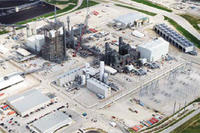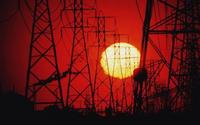-
Feds struggle to plug power grid security holes
Many of the current vulnerabilities in the power grid are attributable to newly adopted smart-grid technology, which allows operators to transmit energy from a diverse pool of resources. Smart-grid technology relies on devices in remote locations which constantly communicate with substations, those access points can be compromised by hackers.
-
-
A grid of the right size could reduce blackout risk
Scientists argue that for every animal there is an optimal size — one which allows it to make best use of its environment and the physical laws that govern its activities, whether hiding, hunting, hoofing, or hibernating. Now, researchers are asking whether there is a “right” size for another type of huge beast: the U.S. power grid. The researchers believe that smaller grids would reduce the likelihood of severe outages, such as the 2003 Northeast blackout that cut power to fifty million people in the United States and Canada for up to two days.
-
-
Controversial Mississippi power station to cut emissions by more than half

A new $5 billion state-of-the-art power facility is under construction Kemper County, Mississippi. It places a firm bet on the future of carbon-capture technology, and other technological advancements, including: it utilizes the gasification process with carbon in unique ways; it recycles treated wastewater to generate power; and it makes money from the carbon dioxide it has removed by selling it to oil companies for their own extraction. Critics say that investing so much money in untested technologies is too much of a gamble.
-
-
NERC drill finds U.S. grid preparedness insufficient
The North American Electric Reliability Corporation (NERC) reported that its recent GridEx II exercise has highlighted the fact that nearly all the utilities which took part in the two-day drill last November – a drill aiming to test the preparedness of the U.S. power grid to withstand cyber and physical attacks – admitted that their planning for such attacks was insufficient. NERC’s president, Gerry Cauley, said that protecting utilities against cyber and physical attacks should be considered in the context of measures taken to protect the grid from other threats. He noted that utilities are already hardening their systems against storms like Hurricane Sandy, while working to determine their vulnerability to solar activity that changes the earth’s magnetic field.
-
-
Small biomass power plants could help rural economies, stabilize national power grid

As energy costs rise, more Americans are turning to bioenergy to provide power to their homes and workplaces. Bioenergy is renewable energy made from organic sources, such as biomass. Technology has advanced enough that biomass power plants small enough to fit on a farm can be built at relatively low costs. Researchers have found that creating a bioenergy grid with these small plants could benefit people in rural areas of the country as well as provide relief to an overworked national power grid.
-
-
FERC orders development of physical security standards for transmission grid
The Federal Energy Regulatory Commission (FERC) on Friday directed the North American Electric Reliability Corporation (NERC) to develop reliability standards requiring owners and operators of the Bulk-Power System to address risks due to physical security threats and vulnerabilities.
-
-
Protecting the grid from geomagnetic storms
A geomagnetic storm disrupts the Earth’s magnetic field by producing geomagnetically induced currents (GICs) on the Earth’s surface, which can enter the power grid at transformer stations and move along power lines, disrupting normal operations. A geomagnetic storm would reach Earth between fourteen and ninety-six hours, leaving little time to safeguard critical infrastructure. U.S. regulators are drafting reliability standards and procedures to protect the U.S. power grid from such storms.
-
-
Power cuts will be more common in the future

U.S. figures show that since 2007, commercial and domestic air-conditioning alone consumed 484billion kilowatt hours of electricity — not much more than the country’s total energy consumption in the mid-1950s. The American Society of Civil Engineers (ASCE) has warned that U.S. generation systems could collapse by 2020 without $100 billion of new investment in power stations. Demands of high-powered electrical appliances, a growing world population, and inadequate investment in the power sector will create more frequent power blackouts in Western societies.
-
-
Old-fashioned way to protect high-voltage substations
There are about 45,000 substations in the United States, but far fewer high-voltage substations like the one attacked last April in Metcalf. California. Americans could see what the loss of just one important power substation can have when, in 2003, a failure in one such substation knocked out power to fifty million people in the United States and Canada for days. Illinois-based IDT says that since Biblical times, the method of thick-walled fortifications to halt manned and artillery attacks remains the best technology for protecting lives and important assets. The company says that its METALITH, a several-feet-thick prefabricated steel barrier structure filled with sand, would offer the best protection to vulnerable power substations. “While most of the electrical industry has been focused on the threat of cyber-terrorism, the San Jose [Metcalf is near San Jose] attack points to the need for physical protection of strategic power grid assets as well,” says Tom Carlton, IDT’s CEO.
-
-
Former FERC chair calls for mandatory security standards for high-voltage substations
Jon Wellinghoff, the former chairman of the Federal Energy Regulatory Commission(FERC), is leading a crusade to improve physical security around the nation’s electrical grid. Following a 16 April 2013 sniper attack on a San Jose, California substation he is urging Congress to give federal agencies the authority to demand improved security around electrical substations. “This isn’t about this substation or this organized attack,” Wellinghoff said of the California incident. “This is more about the larger issue of physical security of these high-voltage substations nationwide and the need to ensure that some defensive measures start to be put in place.”
-
-
Lawmakers want mandatory security standards for national grid
Lawmakers have urged the imposition of federal security standards on grid operator in order to protect the U.S. national electric grid from attack. The new push follows stories, first reported in the Wall Street Journal reported last Wednesday, about a 16 April 2013sniper attack which disabled seventeen transformer in a San Jose, California substation for twenty-seven days, causing about $16 million in damage. Federal cybersecurity standards for protecting the grid are in place and mandated, but rules for protecting physical sites such as transformers and substations are voluntary.
-
-
Children living near overhead power lines do not have greater risk of leukemia
Children who live near overhead power lines in early life do not have a greater risk of developing childhood leukemia, researchers find. The study included nearly 16,500 children who were diagnosed with leukemia in Britain between 1962 and 2008. An earlier study using information on childhood leukemia diagnosed between 1962 and 1995 had suggested that there was an elevated risk for children born within 600 meters of overhead power lines. This new study includes children diagnosed up until 2008, and finds that children born after the 1980s do not have an increased risk.
-
-
Attack on California power station heightens concerns about grid security
Security experts are concerned that last year’s unsolved attack on an electrical-power substation in San Jose, California, is but a prologue to similar attacks which, if executed simultaneously and in a coordinated fashion against several such substations, could cripple the U.S. power grid. The transformers at the substation, vital for regional power distribution, were shot at by several gunmen and disabled for twenty-seven days. What is especially worrisome, security exert note, is that the attack appeared to have been carried out by people with some training, although the FBI said the agency does not think it was the act of terrorists.
-
-
Aging grid cannot keep up with growing demand for electricity
The demand for electricity in the United States increased by around 20 percent from 1999 to 2009, but transmission capacity only increased by around 7 percent in that time. From 2000 to 2004, there were 140 instances of power outages which each affected 50,000 or more consumers. This number increased to 303 from 2005 to 2009. Between 2010 and 2012, there were 226 such outages. The average age of a power plant is 30-years old, and around 75 percent of America’s power lines are 25-years old. Economists estimate that these power outages cost the country more than $70 billion in annual economic loss.
-
-
Making the U.S. grid sturdier, smarter, and more secure to thwart blackouts

In August 2003, fifty million customers throughout the northeastern United States and southeastern Canada lost power for up to two days. More than ten years later, the U.S. electric power system continues to be challenged. In the United States, 149 power outages affecting at least 50,000 customers occurred between 2000 and 2004, a number which grew to 349 between 2005 and 2009. In 2012, the prolonged power outages in New York and New Jersey caused by Hurricane Sandy once again demonstrated the system’s vulnerability. A broad, multidisciplinary effort by Georgia Tech researchers aims to revolutionize the delivery of electricity, advance the smart grid, thwart blackouts, integrate renewable energy sources, and secure utilities from cyberattacks.
-
- All
- Regional
- Water
- Biometrics
- Borders/Immig
- Business
- Cybersecurity
- Detection
- Disasters
- Government
- Infrastructure
- International
- Public health
- Public Safety
- Communication interoperabillity
- Emergency services
- Emergency medical services
- Fire
- First response
- IEDs
- Law Enforcement
- Law Enforcement Technology
- Military technology
- Nonlethal weapons
- Nuclear weapons
- Personal protection equipment
- Police
- Notification /alert systems
- Situational awareness
- Weapons systems
- Sci-Tech
- Sector Reports
- Surveillance
- Transportation
Advertising & Marketing: advertise@newswirepubs.com
Editorial: editor@newswirepubs.com
General: info@newswirepubs.com
2010-2011 © News Wire Publications, LLC News Wire Publications, LLC
220 Old Country Road | Suite 200 | Mineola | New York | 11501
Permissions and Policies
Editorial: editor@newswirepubs.com
General: info@newswirepubs.com
2010-2011 © News Wire Publications, LLC News Wire Publications, LLC
220 Old Country Road | Suite 200 | Mineola | New York | 11501
Permissions and Policies
